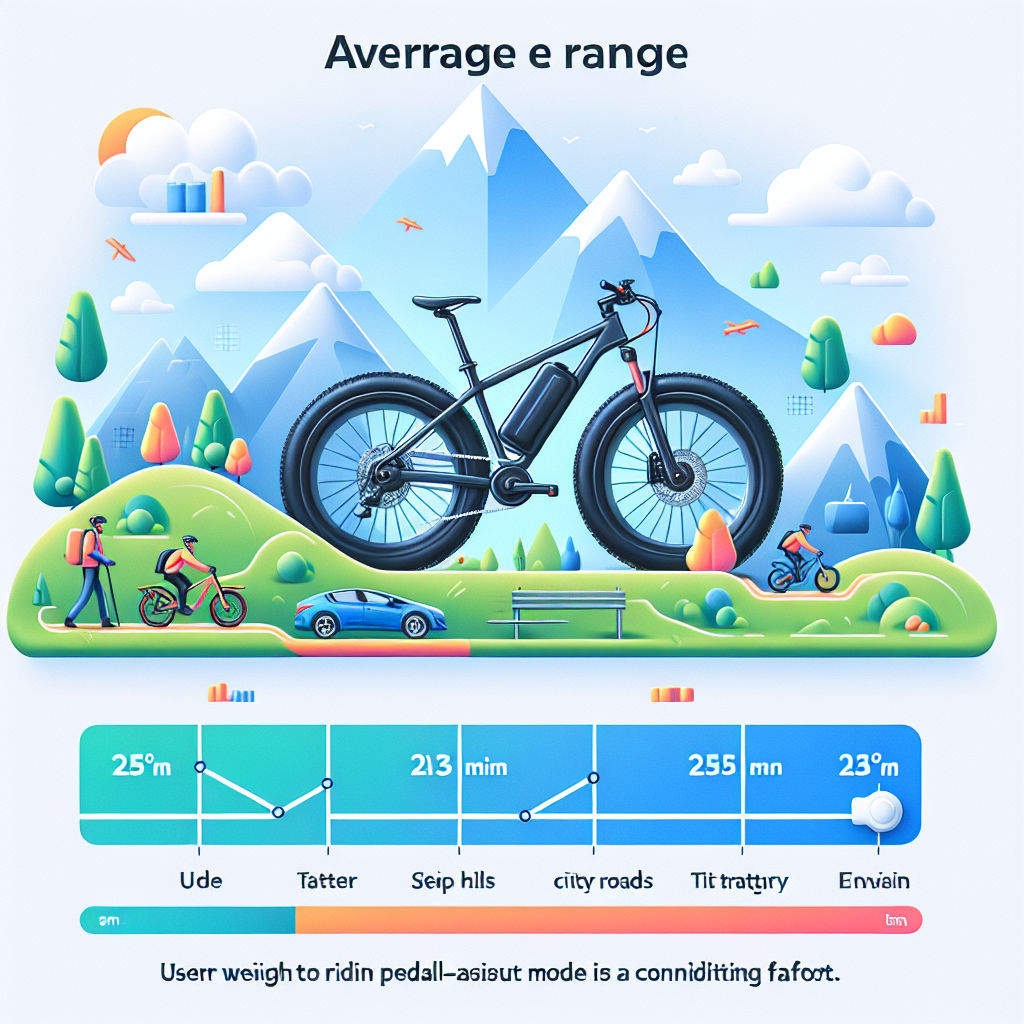Have you ever wondered how far an electric bike can take you on a single charge? Well, you’re in the right place to find out! In this article, we’ll explore the average range of an electric bike and provide you with a better understanding of how much distance you can expect to cover before needing to recharge. Whether you’re a seasoned e-biker or considering purchasing one, knowing the average range will help you plan your rides and make the most out of your electric bike experience. So let’s get started and discover just how far you can go on a single charge!
Factors Affecting Electric Bike Range
Battery Capacity
The range of an electric bike is directly influenced by the capacity of its battery. A higher capacity battery can store more energy and therefore provide a longer range. When choosing an electric bike, it’s important to consider the battery capacity as it determines how far you can ride without recharging.
Motor Power
The power of the electric bike’s motor also plays a significant role in its range. A more powerful motor can provide better assistance, especially when going uphill or riding at higher speeds. However, a more powerful motor may consume more energy, reducing the overall range of the electric bike.
Rider Weight
The weight of the rider is another factor that affects the range of an electric bike. A heavier rider will put more strain on the motor and drain the battery more quickly. If you are on the heavier side, it’s crucial to consider this when estimating the range of your electric bike.
Terrain
The terrain on which you ride your electric bike can have a significant impact on its range. Uphill climbs, rough terrains, and constantly changing surfaces require the motor to work harder, which consumes more energy. Riding on flat, smooth terrains will typically offer a longer range compared to hilly or rough terrains.
Riding Style
Your riding style can affect the range of your electric bike. Aggressive riding, constant acceleration, and excessive use of high assistance levels will drain the battery faster, resulting in a reduced range. On the other hand, adopting a more steady and conservative riding style can help maximize the range of your electric bike.
Assistance Level
Most electric bikes offer different levels of assistance, allowing you to choose the desired level of motor support. Higher assistance levels provide more power, but they also consume more energy and reduce the range. By selecting a lower assistance level when it’s feasible, you can extend the range of your electric bike.
Average Range of Electric Bikes
City Commuter Electric Bikes
City commuter electric bikes are designed for everyday commuting in urban environments. They generally have a more comfortable riding position and focus on efficiency. The average range of city commuter electric bikes can vary significantly depending on factors such as battery capacity, motor power, rider weight, terrain, riding style, and assistance level.
Mountain Electric Bikes
Mountain electric bikes are built to tackle challenging off-road terrains and steep climbs. They usually have more powerful motors and robust frames to withstand the demands of mountain biking. The average range of mountain electric bikes may be slightly lower compared to city commuter electric bikes due to the increased power required for off-road riding.
Cargo Electric Bikes
Cargo electric bikes are designed to carry heavy loads, making them popular among delivery riders and those who need to transport goods. These bikes often have larger battery capacities and more powerful motors to handle the additional weight. As a result, the average range of cargo electric bikes may be slightly lower due to the increased energy consumption.

City Commuter Electric Bikes
City Commuter Electric Bike Range Overview
City commuter electric bikes typically have an average range of 30-60 miles on a single charge. However, this can vary based on various factors such as battery capacity, motor power, rider weight, terrain, riding style, and assistance level. It’s essential to consider these factors when estimating the range of your city commuter electric bike.
Battery Technology and Capacity
The battery technology and capacity of city commuter electric bikes play a crucial role in determining their range. Lithium-ion batteries are commonly used in electric bikes due to their high energy density and light weight. Higher capacity batteries, typically ranging from 300Wh to 600Wh, can provide an extended range for city commuting purposes.
Motor Power and Efficiency
City commuter electric bikes usually have motors with power ratings between 250W and 500W. Higher power motors can provide better assistance, especially when starting from a stop or riding up hills. However, it’s important to balance motor power with efficiency to maximize the range. More efficient motors can help extend the range of city commuter electric bikes.
Mountain Electric Bikes
Mountain Electric Bike Range Overview
Mountain electric bikes generally have a slightly shorter range compared to city commuter electric bikes. Their average range can vary from 20-50 miles depending on battery capacity, motor power, rider weight, terrain, riding style, and assistance level. The increased power requirements for off-road riding contribute to the reduced range.
Battery Technology and Capacity
Mountain electric bikes often feature larger battery capacities ranging from 400Wh to 800Wh to handle the increased power demands of off-road riding. These bikes may incorporate advanced battery technologies to provide a balance between capacity, weight, and overall performance. Choosing a mountain electric bike with a higher capacity battery can help increase its range.
Motor Power and Efficiency
Mountain electric bikes typically have more powerful motors, with power ratings ranging from 500W to 1000W. The added power assists riders in conquering challenging terrains and steep climbs. However, more powerful motors tend to consume more energy, impacting the range. Opting for a motor that offers a good balance between power and efficiency is essential for maximizing the range of mountain electric bikes.
Terrain and Steepness of Climbs
The terrain on which mountain electric bikes are ridden significantly affects their range. Off-road trails with steep climbs and technical sections place a greater demand on the motor, resulting in increased energy consumption. Riding in flatter terrain with fewer obstacles and less challenging climbs can help preserve battery life and extend the range.
Assistance Levels Used
The assistance level chosen by riders when using mountain electric bikes impacts their range. Riding in higher assistance levels provides more power but drains the battery faster. Employing lower assistance levels whenever suitable can help conserve battery energy, thereby extending the range of the mountain electric bike.

Cargo Electric Bikes
Cargo Electric Bike Range Overview
Cargo electric bikes are designed to carry heavy loads, such as groceries or packages. The average range of cargo electric bikes generally falls within the range of 20-40 miles on a single charge. The range can vary depending on battery capacity, motor power, rider weight, terrain, riding style, payload weight, and assistance level.
Battery Technology and Capacity
Cargo electric bikes often come equipped with larger battery capacities to handle the additional weight. Battery capacities typically range from 400Wh to 900Wh, allowing for longer rides without recharging. Consider selecting a cargo electric bike with a higher capacity battery if you need to transport heavy loads over longer distances.
Motor Power and Efficiency
Cargo electric bikes require powerful motors to handle the extra weight they carry. Motors in cargo electric bikes generally range between 500W and 1000W, providing the necessary assistance to tackle inclines and carry heavy loads. Ensuring a good balance between motor power and efficiency is crucial in preserving the range of cargo electric bikes.
Payload Weight
The weight of the cargo being transported on a cargo electric bike directly impacts its range. Heavier loads place more strain on the motor and consume more energy. As a result, the range of a cargo electric bike decreases as the payload weight increases. It’s important to consider the weight of the cargo when estimating the range of a cargo electric bike.
Improving Electric Bike Range
Efficient Riding Technique
Adopting an efficient riding technique can help maximize the range of your electric bike. Smooth and steady acceleration, maintaining a constant speed, and avoiding sudden starts and stops can significantly reduce energy consumption. Additionally, pedaling along with the motor assistance instead of relying solely on the motor can help extend the electric bike’s range.
Battery Capacity Upgrades
If you find that the range of your electric bike is not sufficient for your needs, consider upgrading the battery capacity. Many electric bike manufacturers offer higher capacity battery options as upgrades. By increasing the battery capacity, you can enjoy a longer range and potentially eliminate the need for frequent recharging.
Motor Efficiency Upgrades
Upgrading to a more efficient motor can also help improve the range of your electric bike. Newer motor models often offer improved efficiency, converting more energy from the battery into useful power for propulsion. Upgrading to a more efficient motor can help you go further on a single charge.
Weight Reduction
Reducing the weight of your electric bike can have a significant impact on its range. Removing unnecessary accessories, carrying lighter items, or opting for a lighter frame can help reduce the overall weight of your bike. A lighter electric bike requires less power to propel, resulting in an extended range.
Assistance Level Optimization
Optimizing the usage of assistance levels can help improve the range of your electric bike. Instead of relying heavily on high assistance levels, consider using lower levels when the terrain allows. By only using higher assistance levels when necessary, you can conserve battery energy and maximize your electric bike’s range.

Comparing Electric Bike Models
Manufacturer’s Claimed Range
When researching electric bike models, manufacturers often provide a claimed range for each model. These claimed ranges are typically calculated based on ideal conditions and may not accurately represent real-world scenarios. While it’s helpful to consider the manufacturer’s claimed range, it’s essential to keep in mind that actual range can vary based on factors such as rider weight, terrain, and riding style.
Real-World Rider Feedback
Gathering real-world rider feedback is a valuable source of information when comparing electric bike models. Online forums, social media groups, and customer reviews can provide insights into the real-world range experienced by electric bike owners. Pay attention to feedback from riders with similar riding conditions and preferences to gain a better understanding of the range you can expect from a particular electric bike model.
Range Test Results
Range tests conducted by independent reviewers or organizations can also offer valuable information when comparing electric bike models. These tests involve evaluating electric bikes under controlled conditions to determine their range. By reviewing range test results, you can make more informed decisions and have a better understanding of the actual range provided by different electric bike models.
Factors That Reduce Electric Bike Range
Strong Headwinds
Riding against strong headwinds can significantly reduce the range of an electric bike. The increased wind resistance requires the motor to work harder, resulting in higher energy consumption. To mitigate the impact of strong headwinds, consider using lower assistance levels or seeking sheltered routes when planning your rides.
Hilly Terrain
Climbing steep hills demands more power from the motor, driving up energy consumption and reducing the range of an electric bike. Riding in hilly terrain requires the motor to exert greater effort, especially in higher assistance levels. Choosing flatter routes whenever possible can help preserve battery life and extend the range of your electric bike.
Suboptimal Tire Pressure
Underinflated tires create more rolling resistance, forcing the motor to work harder and consume more energy. It’s important to regularly check and maintain the optimal tire pressure recommended by the manufacturer. By keeping your electric bike’s tires properly inflated, you can increase its range and overall efficiency.
Cold Weather
Cold weather can negatively affect the range of an electric bike. Low temperatures cause the battery to have reduced efficiency and deliver less power. It’s advisable to keep the battery warm, either by insulating it or using battery warmers, to maintain optimal performance and maximize the range during colder rides.
Extreme Weight
Excessive weight, such as carrying heavy loads or a lot of accessories, can significantly impact the range of an electric bike. The extra weight places higher demands on the motor and drains the battery more quickly. To maintain a longer range, it’s important to keep the weight of your electric bike and any additional cargo as low as possible.
Aggressive Riding Style
An aggressive riding style, with frequent acceleration and deceleration, increases energy consumption and reduces the range of an electric bike. Smooth and steady riding techniques, accompanied by gradual acceleration and deceleration, can help conserve energy and extend the range. Cultivating a more relaxed riding style can make a noticeable difference in your electric bike’s range.

Mitigating Factors that Reduce Range
Pedal-Assist Mode
Engaging the pedal-assist mode on your electric bike can significantly extend its range. Pedaling along with the motor assistance reduces the load on the motor, resulting in decreased energy consumption. By actively contributing to the propulsion of the bike, you can conserve battery energy and enjoy a longer range.
Proper Tire Inflation
Maintaining the proper tire pressure in your electric bike’s tires has multiple benefits, including increasing range. Properly inflated tires reduce rolling resistance, allowing the motor to operate more efficiently. Regularly checking and inflating your tires to the recommended pressure will help optimize your electric bike’s range.
Battery Warmers
In colder weather conditions, using battery warmers can help improve the range of an electric bike. Battery warmers keep the battery at an optimal temperature, ensuring it delivers consistent power. By maintaining the battery at an ideal temperature, you can counteract the performance decrease associated with cold weather and maximize the range of your electric bike.
Conclusion
Importance of Understanding Electric Bike Range
Understanding the factors that affect electric bike range is vital when choosing an electric bike that aligns with your needs and preferences. By considering factors such as battery capacity, motor power, rider weight, terrain, riding style, and assistance level, you can make an informed decision and select an electric bike with an appropriate range for your intended usage.
Range Considerations for Different Uses
The average range of electric bikes varies depending on the type and intended usage. City commuter electric bikes generally offer ranges between 30-60 miles, while mountain electric bikes and cargo electric bikes may have slightly shorter ranges due to the increased power requirements. When selecting an electric bike, consider the average range for each type and match it with your intended usage to ensure it meets your requirements.
Technological Advancements
Technological advancements in battery technology, motor efficiency, and electric bike design continue to improve the range capabilities of electric bikes. Higher capacity batteries, more efficient motors, and lighter bike components are being developed to increase the range and overall performance of electric bikes. As technology progresses, future electric bike models are likely to offer even longer ranges, providing riders with more options and opportunities for exploration.


